Managing Organizational Change: Cisco, IDEO, and Decision Making
VerifiedAdded on 2022/10/10
|5
|850
|210
Report
AI Summary
This report delves into the intricacies of managing organizational change, exploring various facets such as types of change, organizational transformation, and the influence of decision-making, learning, knowledge management, and IT. It analyzes the resistance to change, addressing issues like process adaptation, diversity, skill acquisition, and layoffs. The report examines Cisco's transformation over the past decade, highlighting its organic management control, diversification, and product evolution. It also explores IDEO's approach to decision-making, emphasizing creative confidence, brainstorming, and the 'garbage can' thinking model. The report provides insights into how these strategies can be applied to enhance organizational performance and adapt to changing market dynamics. References from academic sources support the analysis.
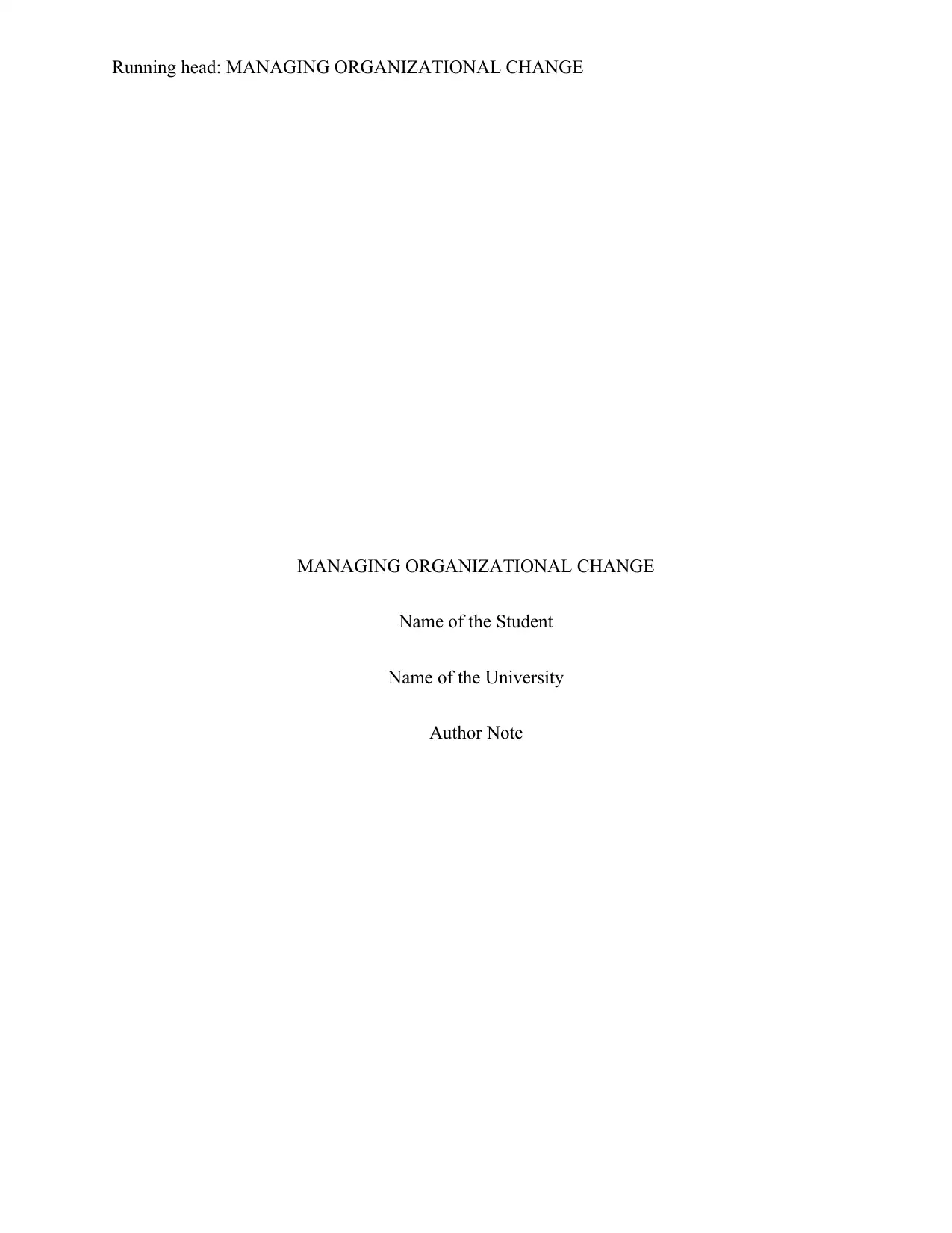
Running head: MANAGING ORGANIZATIONAL CHANGE
MANAGING ORGANIZATIONAL CHANGE
Name of the Student
Name of the University
Author Note
MANAGING ORGANIZATIONAL CHANGE
Name of the Student
Name of the University
Author Note
Paraphrase This Document
Need a fresh take? Get an instant paraphrase of this document with our AI Paraphraser
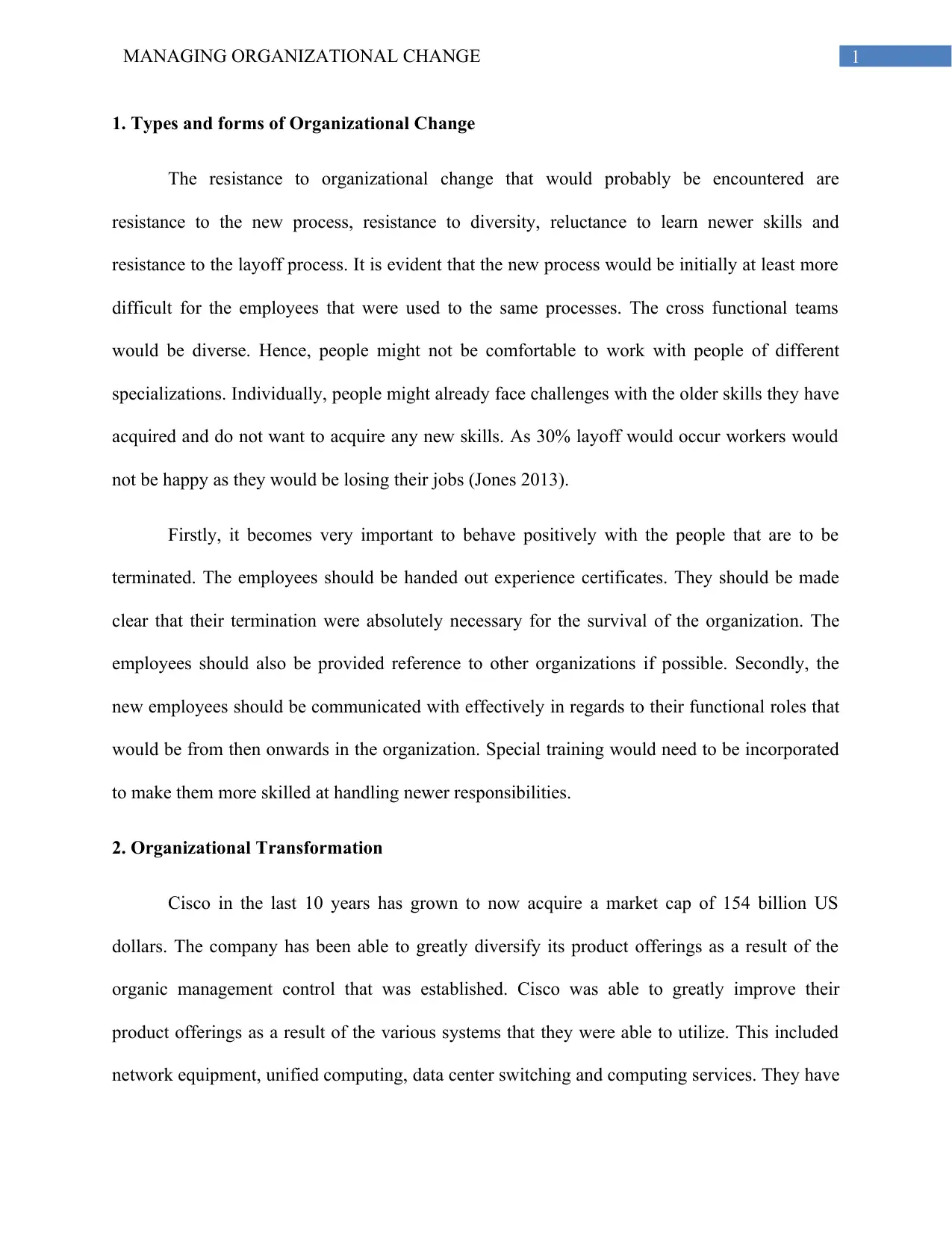
1MANAGING ORGANIZATIONAL CHANGE
1. Types and forms of Organizational Change
The resistance to organizational change that would probably be encountered are
resistance to the new process, resistance to diversity, reluctance to learn newer skills and
resistance to the layoff process. It is evident that the new process would be initially at least more
difficult for the employees that were used to the same processes. The cross functional teams
would be diverse. Hence, people might not be comfortable to work with people of different
specializations. Individually, people might already face challenges with the older skills they have
acquired and do not want to acquire any new skills. As 30% layoff would occur workers would
not be happy as they would be losing their jobs (Jones 2013).
Firstly, it becomes very important to behave positively with the people that are to be
terminated. The employees should be handed out experience certificates. They should be made
clear that their termination were absolutely necessary for the survival of the organization. The
employees should also be provided reference to other organizations if possible. Secondly, the
new employees should be communicated with effectively in regards to their functional roles that
would be from then onwards in the organization. Special training would need to be incorporated
to make them more skilled at handling newer responsibilities.
2. Organizational Transformation
Cisco in the last 10 years has grown to now acquire a market cap of 154 billion US
dollars. The company has been able to greatly diversify its product offerings as a result of the
organic management control that was established. Cisco was able to greatly improve their
product offerings as a result of the various systems that they were able to utilize. This included
network equipment, unified computing, data center switching and computing services. They have
1. Types and forms of Organizational Change
The resistance to organizational change that would probably be encountered are
resistance to the new process, resistance to diversity, reluctance to learn newer skills and
resistance to the layoff process. It is evident that the new process would be initially at least more
difficult for the employees that were used to the same processes. The cross functional teams
would be diverse. Hence, people might not be comfortable to work with people of different
specializations. Individually, people might already face challenges with the older skills they have
acquired and do not want to acquire any new skills. As 30% layoff would occur workers would
not be happy as they would be losing their jobs (Jones 2013).
Firstly, it becomes very important to behave positively with the people that are to be
terminated. The employees should be handed out experience certificates. They should be made
clear that their termination were absolutely necessary for the survival of the organization. The
employees should also be provided reference to other organizations if possible. Secondly, the
new employees should be communicated with effectively in regards to their functional roles that
would be from then onwards in the organization. Special training would need to be incorporated
to make them more skilled at handling newer responsibilities.
2. Organizational Transformation
Cisco in the last 10 years has grown to now acquire a market cap of 154 billion US
dollars. The company has been able to greatly diversify its product offerings as a result of the
organic management control that was established. Cisco was able to greatly improve their
product offerings as a result of the various systems that they were able to utilize. This included
network equipment, unified computing, data center switching and computing services. They have
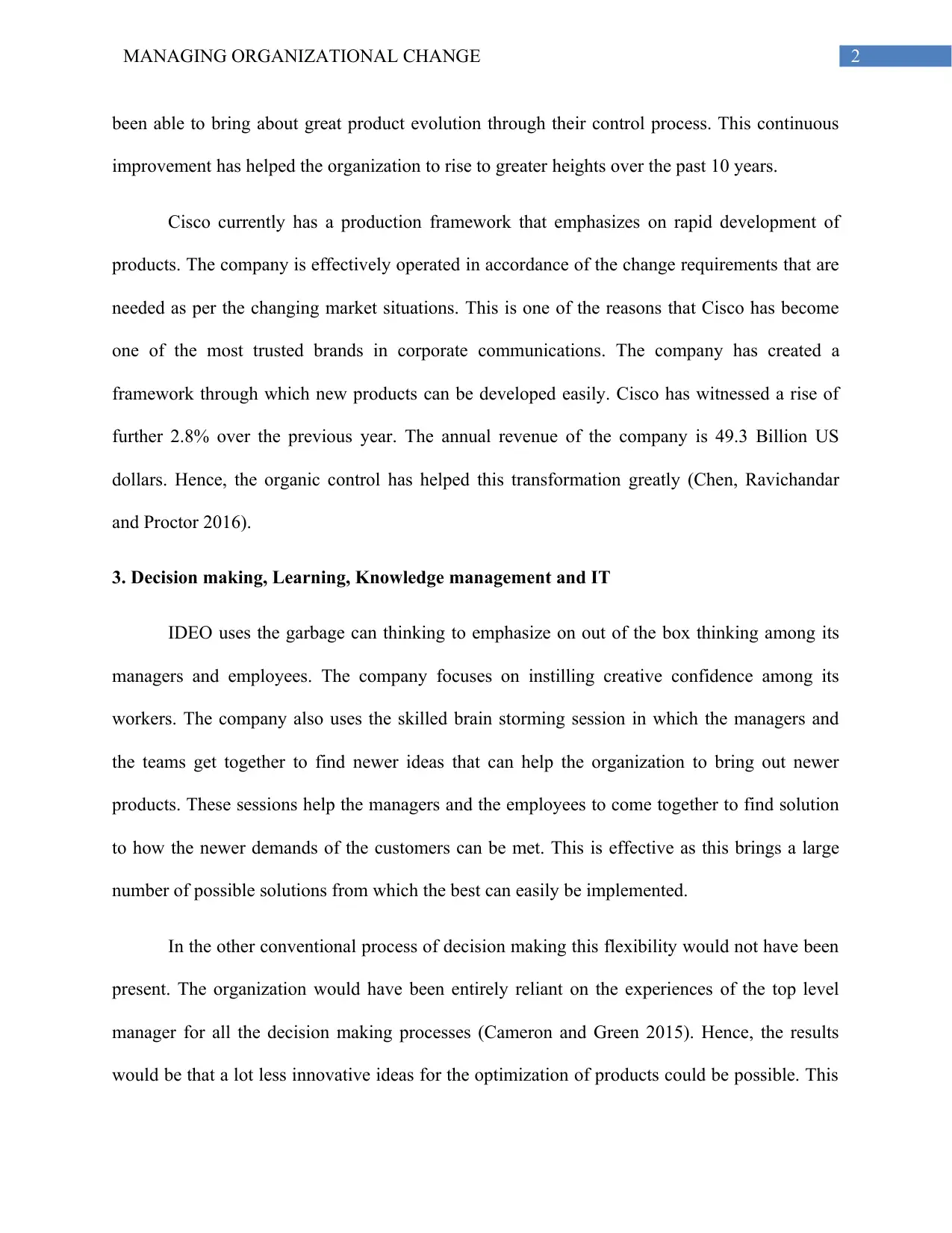
2MANAGING ORGANIZATIONAL CHANGE
been able to bring about great product evolution through their control process. This continuous
improvement has helped the organization to rise to greater heights over the past 10 years.
Cisco currently has a production framework that emphasizes on rapid development of
products. The company is effectively operated in accordance of the change requirements that are
needed as per the changing market situations. This is one of the reasons that Cisco has become
one of the most trusted brands in corporate communications. The company has created a
framework through which new products can be developed easily. Cisco has witnessed a rise of
further 2.8% over the previous year. The annual revenue of the company is 49.3 Billion US
dollars. Hence, the organic control has helped this transformation greatly (Chen, Ravichandar
and Proctor 2016).
3. Decision making, Learning, Knowledge management and IT
IDEO uses the garbage can thinking to emphasize on out of the box thinking among its
managers and employees. The company focuses on instilling creative confidence among its
workers. The company also uses the skilled brain storming session in which the managers and
the teams get together to find newer ideas that can help the organization to bring out newer
products. These sessions help the managers and the employees to come together to find solution
to how the newer demands of the customers can be met. This is effective as this brings a large
number of possible solutions from which the best can easily be implemented.
In the other conventional process of decision making this flexibility would not have been
present. The organization would have been entirely reliant on the experiences of the top level
manager for all the decision making processes (Cameron and Green 2015). Hence, the results
would be that a lot less innovative ideas for the optimization of products could be possible. This
been able to bring about great product evolution through their control process. This continuous
improvement has helped the organization to rise to greater heights over the past 10 years.
Cisco currently has a production framework that emphasizes on rapid development of
products. The company is effectively operated in accordance of the change requirements that are
needed as per the changing market situations. This is one of the reasons that Cisco has become
one of the most trusted brands in corporate communications. The company has created a
framework through which new products can be developed easily. Cisco has witnessed a rise of
further 2.8% over the previous year. The annual revenue of the company is 49.3 Billion US
dollars. Hence, the organic control has helped this transformation greatly (Chen, Ravichandar
and Proctor 2016).
3. Decision making, Learning, Knowledge management and IT
IDEO uses the garbage can thinking to emphasize on out of the box thinking among its
managers and employees. The company focuses on instilling creative confidence among its
workers. The company also uses the skilled brain storming session in which the managers and
the teams get together to find newer ideas that can help the organization to bring out newer
products. These sessions help the managers and the employees to come together to find solution
to how the newer demands of the customers can be met. This is effective as this brings a large
number of possible solutions from which the best can easily be implemented.
In the other conventional process of decision making this flexibility would not have been
present. The organization would have been entirely reliant on the experiences of the top level
manager for all the decision making processes (Cameron and Green 2015). Hence, the results
would be that a lot less innovative ideas for the optimization of products could be possible. This
⊘ This is a preview!⊘
Do you want full access?
Subscribe today to unlock all pages.

Trusted by 1+ million students worldwide
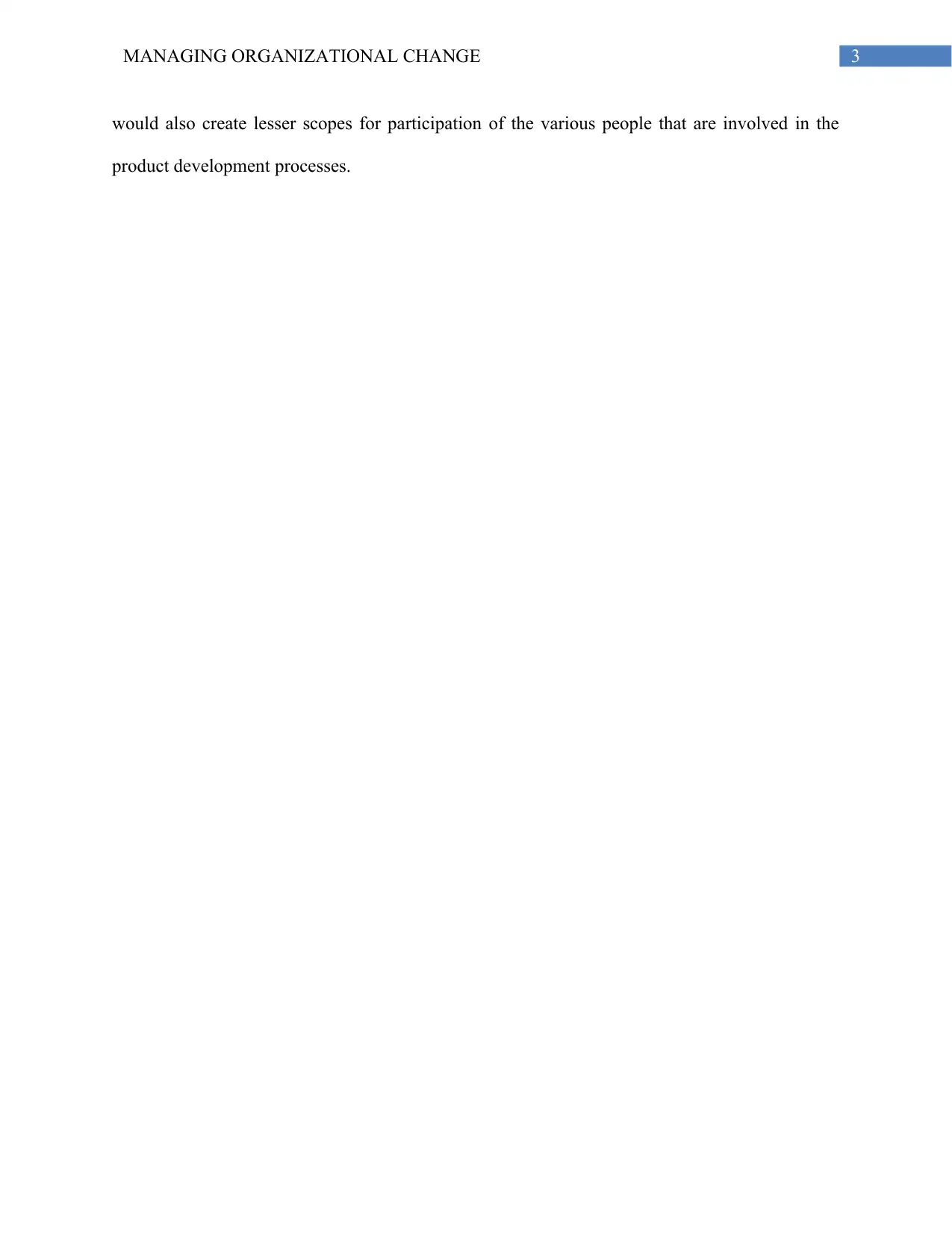
3MANAGING ORGANIZATIONAL CHANGE
would also create lesser scopes for participation of the various people that are involved in the
product development processes.
would also create lesser scopes for participation of the various people that are involved in the
product development processes.
Paraphrase This Document
Need a fresh take? Get an instant paraphrase of this document with our AI Paraphraser
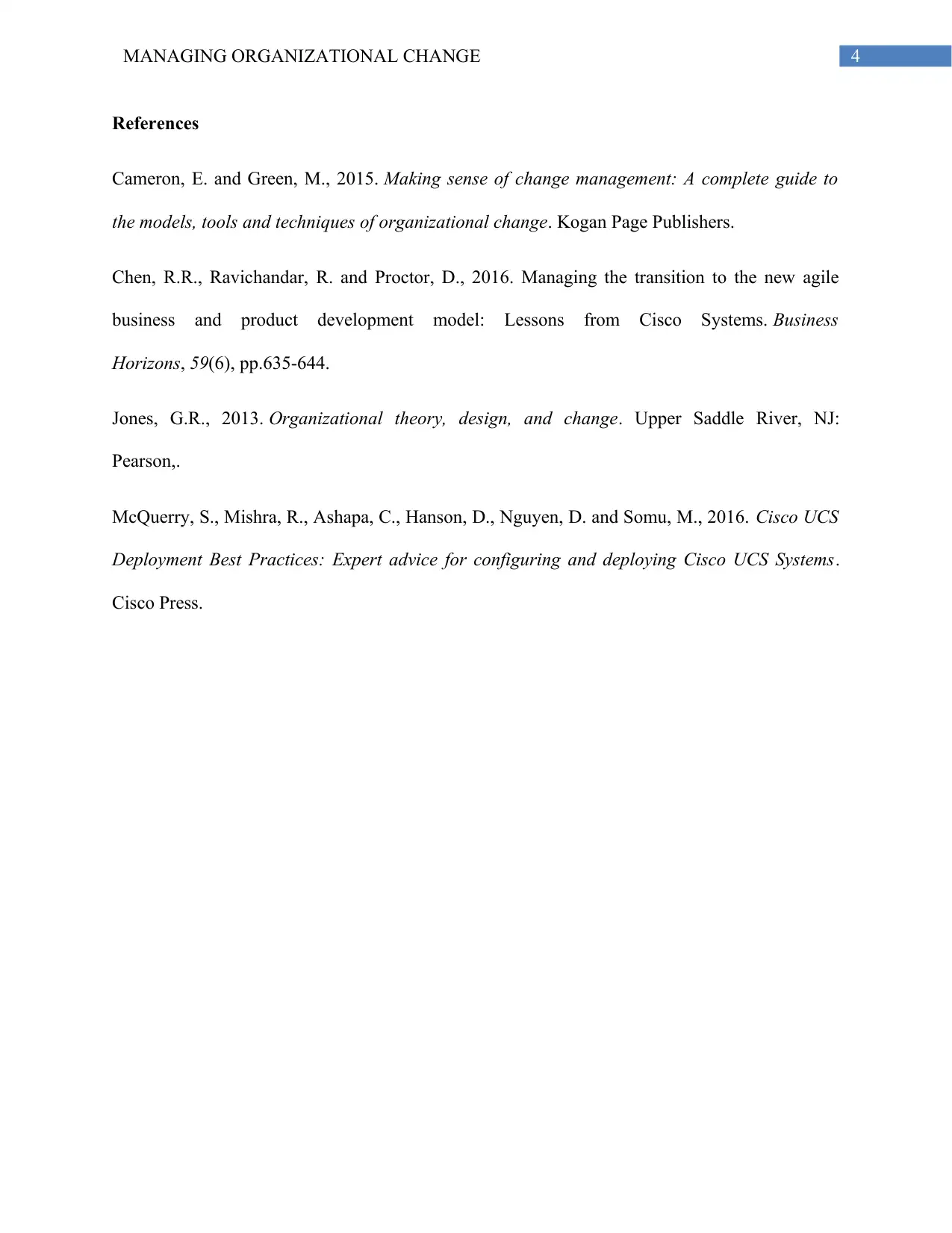
4MANAGING ORGANIZATIONAL CHANGE
References
Cameron, E. and Green, M., 2015. Making sense of change management: A complete guide to
the models, tools and techniques of organizational change. Kogan Page Publishers.
Chen, R.R., Ravichandar, R. and Proctor, D., 2016. Managing the transition to the new agile
business and product development model: Lessons from Cisco Systems. Business
Horizons, 59(6), pp.635-644.
Jones, G.R., 2013. Organizational theory, design, and change. Upper Saddle River, NJ:
Pearson,.
McQuerry, S., Mishra, R., Ashapa, C., Hanson, D., Nguyen, D. and Somu, M., 2016. Cisco UCS
Deployment Best Practices: Expert advice for configuring and deploying Cisco UCS Systems.
Cisco Press.
References
Cameron, E. and Green, M., 2015. Making sense of change management: A complete guide to
the models, tools and techniques of organizational change. Kogan Page Publishers.
Chen, R.R., Ravichandar, R. and Proctor, D., 2016. Managing the transition to the new agile
business and product development model: Lessons from Cisco Systems. Business
Horizons, 59(6), pp.635-644.
Jones, G.R., 2013. Organizational theory, design, and change. Upper Saddle River, NJ:
Pearson,.
McQuerry, S., Mishra, R., Ashapa, C., Hanson, D., Nguyen, D. and Somu, M., 2016. Cisco UCS
Deployment Best Practices: Expert advice for configuring and deploying Cisco UCS Systems.
Cisco Press.
1 out of 5
Related Documents
Your All-in-One AI-Powered Toolkit for Academic Success.
+13062052269
info@desklib.com
Available 24*7 on WhatsApp / Email
![[object Object]](/_next/static/media/star-bottom.7253800d.svg)
Unlock your academic potential
Copyright © 2020–2025 A2Z Services. All Rights Reserved. Developed and managed by ZUCOL.





